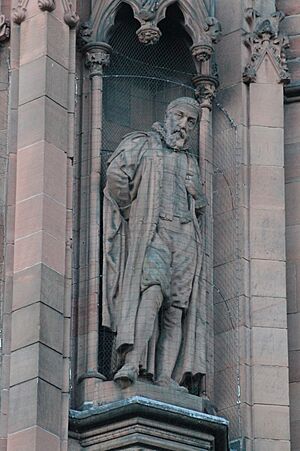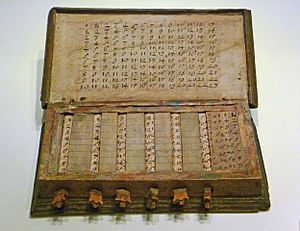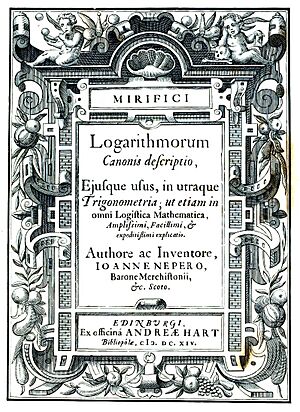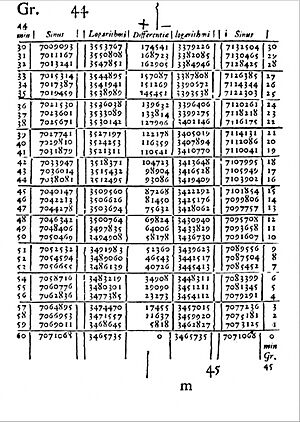John Napier facts for kids
Quick facts for kids
John Napier
|
|
|---|---|
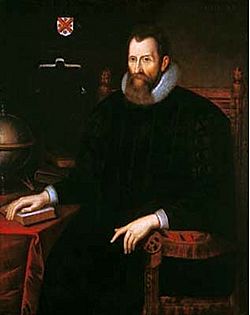
John Napier (1550–1617)
|
|
| Born | 1 February 1550 |
| Died | 4 April 1617 (aged 66–67) Edinburgh, Scotland
|
| Nationality | Scottish |
| Alma mater | University of St Andrews |
| Known for | Logarithms Napier's bones Decimal notation Spherical trigonometry |
| Scientific career | |
| Fields | Mathematician |
| Influenced | Henry Briggs |
John Napier (born February 1, 1550 – died April 4, 1617) was a clever Scottish landowner. People sometimes called him Marvellous Merchiston. He was a mathematician, a physicist, and an astronomer. He is most famous for inventing logarithms, which made big calculations much easier.
Napier also created a special tool called "Napier's bones" to help with multiplication. He also helped make the decimal point (like the dot in 3.14) a common part of math.
John Napier was born at Merchiston Tower in Edinburgh, Scotland. This building is now part of Edinburgh Napier University. You can find a memorial to him at St Cuthbert's Parish Church in Edinburgh.
Contents
Life of a Scottish Thinker
John Napier's father was Sir Archibald Napier. His mother was Janet Bothwell. John's father was only 16 years old when John was born!
We don't know much about Napier's early schooling. Many people think he had private teachers at home. When he was 13, he started studying at St Salvator's College, St Andrews. The university wasn't at its best then. This was because of big changes happening in religion (the Reformation).
Napier probably didn't finish his studies at St Andrews. His uncle, Adam Bothwell, suggested he go to Europe to learn more. So, it's believed Napier left Scotland to study in places like France or Flanders. We don't know exactly which university he went to. But when he came back to Scotland in 1571, he could speak Greek very well. This was a language not many people learned back then.
In 1571, when he was 21, Napier returned to Scotland. He bought a castle in Gartness in 1574. After his father passed away in 1608, Napier and his family moved into Merchiston Castle in Edinburgh. He lived there for the rest of his life.
Napier was interested in more than just math. In 1596, he wrote a paper called Secret inventions, profitable and necessary in these days for defence of this island. In it, he described ideas for special mirrors to burn enemy ships from far away. He also wrote about new types of cannonballs and a metal chariot that muskets couldn't shoot through.
John Napier died at home in Merchiston Castle when he was 67. He was buried in Edinburgh. Later, his remains were moved to an underground vault at St Cuthbert's Parish Church.
Many mathematicians at that time found calculations very hard. Napier wanted to make math easier for everyone. He became famous for his tools that helped with numbers. His most well-known invention was "Napier's bones." These were clever rods that helped people multiply and divide.
Napier also saw how new math ideas could help. He used ideas like decimal fractions to make calculations simpler. He knew that many people needed help with trigonometry, a type of math used for triangles. So, he made sure his logarithms could be used easily with trigonometry.
Amazing Math Inventions

Napier's most important math book was called Mirifici Logarithmorum Canonis Descriptio (which means "Description of the Wonderful Rule of Logarithms"). It came out in 1614. This book had many pages explaining logarithms and tables of numbers. It also had important rules for spherical trigonometry, which is math used for shapes on a sphere, like the Earth.
You can find modern English versions of Napier's books online. You can also learn more about his "Napier's bones" and another early calculating tool called the Promptuary.
His invention of logarithms quickly became popular. An important English mathematician named Henry Briggs visited Napier in 1615. They talked about how to make Napier's logarithms even better.
Logarithms made calculations by hand much, much faster. This opened the door for many later scientific discoveries. They helped in astronomy (the study of stars), dynamics (the study of motion), and other areas of physics.
Napier also made other important contributions. He improved the way we write decimal notation, using a period (.) to separate the whole number from the fraction. His "Napier's bones" also made lattice multiplication easier.
Napier worked mostly on his own. But he did connect with other smart people like Tycho Brahe, a famous astronomer.
His Religious Beliefs
Napier was very interested in the Book of Revelation from the Bible. He believed that the Pope was the Antichrist, a very strong anti-Catholic view at the time.
Napier thought his most important work was a book called A Plaine Discovery of the Whole Revelation of St. John (1593). He wrote it in English, not Latin, so that more people in Scotland could read it. In this book, Napier used math to try and guess when the end of the world would happen. He thought the Bible gave clues about the future. He predicted the end of the world might happen in 1688 or 1700. Napier believed God wanted people to know when the end was coming.
His book was very popular in Scotland and other countries. It was translated into Dutch, French, and German.
Mysterious Interests
Besides math and religion, some people thought Napier was a magician. They believed he was involved in alchemy (trying to turn metals into gold) and necromancy (talking to the dead). People said he carried a black spider in a box. They also thought his black rooster was a "familiar spirit," a helper for a witch or wizard.
Some of Napier's neighbors even accused him of being a sorcerer. They thought he spent all his time in his study learning dark magic. These rumors grew when Napier used his black rooster to catch a thief! Napier told his servants to go into a dark room and pet the rooster. He said the bird would crow if they were the thief. What the servants didn't know was that Napier had covered the rooster with soot. When they came out, Napier checked their hands. The one with clean hands was too scared to touch the rooster, showing they were the thief!
Another story says Napier got rid of pigeons from his land because they were eating his grain. To the locals, this might have seemed like a magical act.
There's even a contract that still exists for a treasure hunt between Napier and Robert Logan. Napier was supposed to search Fast Castle for hidden treasure. The contract said Napier should "do his utmost diligence to search and seek out, and by all craft and ingine to find out the same." Napier never found any gold there.
His Lasting Impact
John Napier's work had a huge impact. His invention of logarithms helped make decimal arithmetic (our normal number system) much more common.
Henry Briggs quickly started using Napier's logarithms. He later created a new table of logarithms that were very accurate.
Things Named After Him
Many things are named after John Napier:
- The neper is a unit used in electrical engineering, similar to the decibel.
- Edinburgh Napier University in Scotland is named after him.
- A crater on the Moon is called Neper.
- In French and Portuguese, the natural logarithm is called by his name.
- In Italian, the mathematical constant e is called Numero di Nepero.
His Family
In 1572, Napier married Elizabeth Stirling when she was 16. They had two children. Elizabeth died in 1579. Napier then married Agnes Chisholm, and they had ten more children!
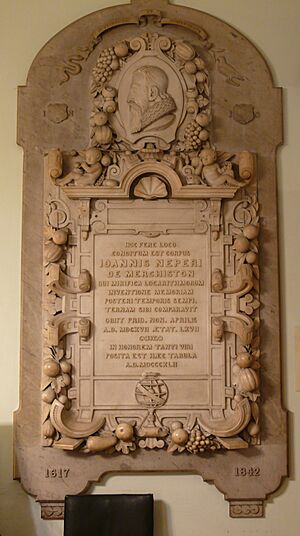
Images for kids
See also
 In Spanish: John Napier para niños
In Spanish: John Napier para niños


